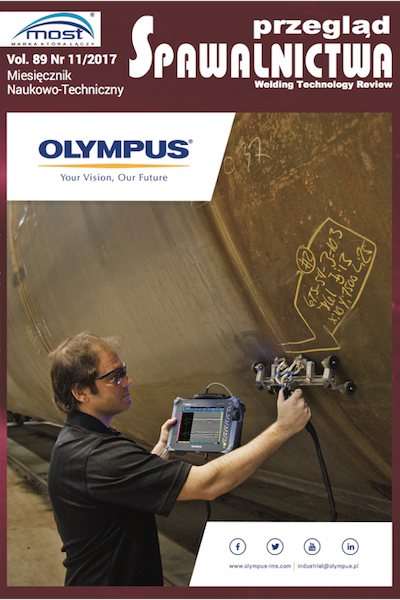Identification of the material state of turbine rotors using non-destructive methods
##plugins.themes.bootstrap3.article.main##
Abstrakt
During durability assessment of steam turbine rotors it is problematic to determine the actual properties of the material. Analysis of microstructure, chemical composition, hardness measurements and defectoscopic examinations are the contemporary methods used in the assessment of such objects. Usually the real macroscopic mechanical properties remains unknown because their determination requires a destructive testing that requires large specimens to be taken from the rotor, which is not practically practiced. The paper presents the possibilities of the small punch test method (SPT) which bases on small specimens. The SPT method is a formally destructive method of material examination, however, because of the insufficient amount of material necessary to prepare specimens, it can be treated as a non- destructive method of material testing. Moreover the place of sampling does not require repair. Using the SPT method, it is possible to determine the basic mechanical properties of a material normally determined by a tensile test such as the Youngs modulus E, yield stress Re or ultimate stress Rm, and properties determined by Charpy impact test in example fracture appearance transition temperature or fracture strength. It is also possible to determine the material properties under creep conditions.
in polish
Identyfikacja stanu tworzywa wirników turbin parowych metodami nieniszczącymi
Przy ocenie stanu technicznego wirników turbin parowych problematyczne jest określenie rzeczywistych własności tworzywa. Analiza mikrostruktury, składu chemicznego, pomiary twardości oraz badania defektoskopowe stanowią współcześnie obowiązujący w diagnostyce tego typu obiektów kanon metod badawczych. Najczęściej nieznane pozostają rzeczywiste makroskopowe własności wytrzymałościowe, ponieważ ich wyznaczenie wymaga przeprowadzenia badań niszczących, które wymagają pobrania z wirnika próbek o znacznych rozmiarach, czego w zasadzie się nie praktykuje. W artykule pokazano możliwości metody badawczej wykorzystującej małe próbki Small Punch Test (SPT). Metoda SPT jest formalnie metodą niszczącą, jednak ze względu na znikomą ilość materiału pobieranego do badania można ją traktować jako metodę nieniszczącą, a miejsce pobrania próbki z wirnika nie wymaga naprawy. Za pomocą metody SPT możliwe jest wyznaczanie podstawowych własności mechanicznych materiału, określanych normalnie za pomocą statycznej próby rozciągania, takich jak moduł Younga E, granica plastyczności Re czy wytrzymałość na rozciąganie Rm oraz wielkości normalnie wyznaczanych za pomocą badania udarności, tj. temperatury przejścia plastyczno-kruchego czy odporności materiału na pękanie. Istnieje również możliwość okre ślania własności materiału przy pełzaniu.
Pobrania
##plugins.themes.bootstrap3.article.details##
Creative Commons CC BY 4.0 https://creativecommons.org/licenses/by/4.0/
Artykuły czasopisma Welding Technology Review (Przegląd Spawalnictwa) publikowane są w otwartym dostępie na licencji CC BY (licencja Creative Commons Uznanie autorstwa 4.0 Międzynarodowe). Licencja CC BY jest najbardziej otwartą dostępną licencją i uważaną za „złoty standard” w formule otwartego dostępu; jest również preferowany przez wielu fundatorów badań. Licencja ta umożliwia czytelnikom kopiowanie i redystrybucję materiału na dowolnym nośniku i w dowolnym formacie, a także zmienianie, przekształcanie lub budowanie na nim materiału, w tym do użytku komercyjnego, pod warunkiem wskazania oryginalnego autora.
Bibliografia
Bieniek M.: Ocena bezpieczeństwa eksploatacji maszyn i urządzeń energetycznych o znacznym stopniu zużycia, Rozprawa doktorska, Gliwice 2014.
Fleury E., Ha J.S.: Small punch tests to estimate the mechanical properties of steels for steam power plant: I, Mechanical strength, International Journal of Pressure Vessels and Piping, 1998, Vol. 75, pp. 699-706.
Fleury E.: Small punch tests to estimate the mechanical properties of steels for steam power plant: II, Fracture toughness, International Journal of Pressure Vessels and Piping, 1998, Vol. 75, pp. 707-713.
Izaki T., Kobayashi T., Kusumoto J., Kanaya A.: A creep life assessment method for boiler pipes using small punch creep test, International Journal of Pressure Vessels and Piping, 2009, Vol. 86, pp. 637-642.
Klevtsov I., Dedov A., Molodtsov A.: Using of small punch test for determination of tensile properties for power plant steels, 6th International Daaam Baltic Conference Industrial Engineering, Tallin, 24-26 April 2008.
Norma PKN-CEN/CWA 15627: Small Punch Test Method for Metallic Materials.
Shekhter A., Croker A.B.l., Hellier A.K., Moss C.J., Ringer S.P.: Towards the correlation of fracture toughness in an ex-service power generating rotor, International Journal of Pressure Vessels and Piping, 2000, Vol. 77, pp. 113-116.
Song S.H., Faulkner R.G., Flewitt P.E.J., Smith R.F., Marmy P.: Temper embrittlement of a CrMo low-alloy steel evaluated by means of small punch testing, Material Science and Engineering A, 2000, Vol. 281, pp. 75-81.
Yang Z., Wang Z.: Relationship between strain and central de ection in small punch creep specimens, International Journal of Pressure Vessels and Piping, 2003, Vol. 80, pp. 397-404.
